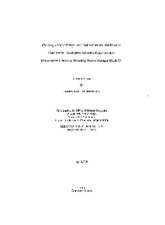| dc.creator | Herrera, Leeha Rae-Lyn | |
| dc.date.accessioned | 2013-02-22T20:41:01Z | |
| dc.date.available | 2013-02-22T20:41:01Z | |
| dc.date.created | 2000 | |
| dc.date.issued | 2013-02-22 | |
| dc.identifier.uri | https://hdl.handle.net/1969.1/ETD-TAMU-2000-Fellows-Thesis-H475 | |
| dc.description | Due to the character of the original source materials and the nature of batch digitization, quality control issues may be present in this document. Please report any quality issues you encounter to digital@library.tamu.edu, referencing the URI of the item. | en |
| dc.description | Includes bibliographical references (leaf 18). | en |
| dc.description.abstract | Requirements management has been a traditionally overlooked aspect in designing software based systems. This lack of emphasis on managing requirements has lead to a large percent of projects either failing to meet all the needs of the customer, or in extreme cases, being cancelled when budgets or schedules have been exceeded. Companies could potentially save time and money by ensuring that requirements are accurately represented in each phase of development. The purpose of my research is to design a tool that will aid in tracing requirements throughout the software development lifecycle. The tool, named Requirement Lifecycle Modeling Views (RLMV), follows the architecture, as defined in The Unified Modeling Language Users Guide, for modeling software-intensive systems. This architecture is based on five views which are the use case view, design view, process view, implementation view, and deployment view. These views work together to define the modeling of a system by representing different aspects of the system, as it is developed. RLMV works with existing software tools created by a corporation named Rational. The tool itself is implemented using Java and Oracle. RLMV is designed to trace pre-defined requirements to modeling diagrams created for each of the five views. Though the tool was designed to work with Rational RequisitePro and Rational Rose, it is generalized enough to work with most software designing tools. In this manner, a user can select a requirement and display the names of diagrams and files, for each phase of development, associated with that requirement. The benefit to RLMV is that a user can actively trace the requirement through development to ensure that each requirement is being satisfied and prevent deviations. | en |
| dc.format.medium | electronic | en |
| dc.format.mimetype | application/pdf | |
| dc.language.iso | en_US | |
| dc.publisher | Texas A&M University | |
| dc.rights | This thesis was part of a retrospective digitization project authorized by the Texas A&M University Libraries in 2008. Copyright remains vested with the author(s). It is the user's responsibility to secure permission from the copyright holder(s) for re-use of the work beyond the provision of Fair Use. | en |
| dc.subject | computer science. | en |
| dc.subject | Major computer science. | en |
| dc.title | Creating a methodology and tool to capture and resolve conflicts in developing software requirements: Requirement Lifecycle Modeling Views manager (RLMV) | en |
| thesis.degree.department | computer science | en |
| thesis.degree.discipline | computer science | en |
| thesis.degree.name | Fellows Thesis | en |
| thesis.degree.level | Undergraduate | en |
| dc.type.genre | thesis | en |
| dc.type.material | text | en |
| dc.format.digitalOrigin | reformatted digital | en |


